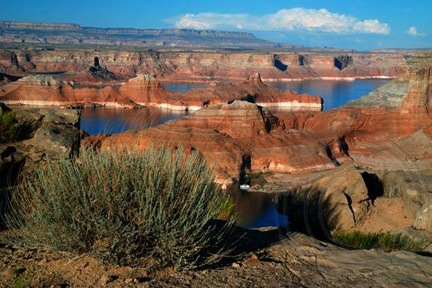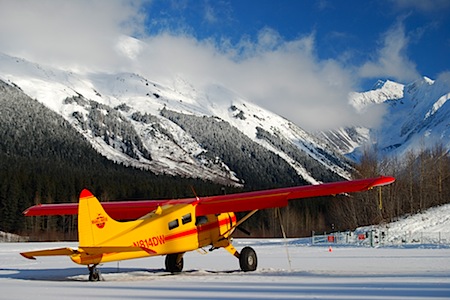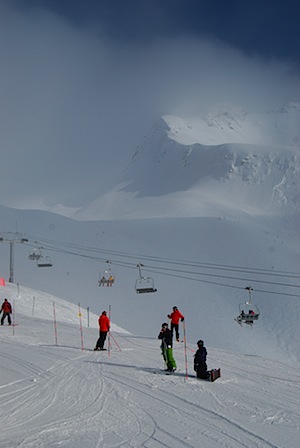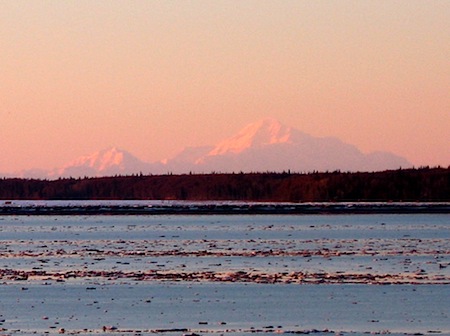It’s nice when travel goes smoothly.
Last June, Mike and I went to Alaska for vacation. Our travel plans, which were made by a real travel agent, were completely screwed up, as I detailed in “Trouble on the Tundra” in this blog.
While I think the travel agent was to blame for our screwed up hotel arrangements on that trip, I can’t blame her for airline delays. I blame the airline — Alaska Airlines — for that. Unfortunately, I had to fly with the same airline again yesterday. Fortunately, when they get it right, they do a good job. And they got it right yesterday.
But I’m getting ahead of myself a bit.
I want to fly in Alaska this summer. Last week, I lined up a job interview with a company based in Girdwood, AK, which is just south of Anchorage. Here’s a quick summary of yesterday’s flight to Alaska from Phoenix.
Before the Crack of Dawn
My flight was scheduled to leave Phoenix at 6 AM, so I was up and getting ready to go at 3 AM. I was out the door in the cool, predawn morning at 3:30 and, after a quick stop for gas in my Honda, was on the road heading out of Wickenburg at 3:45 AM.
The thought of this would send many late risers into cardiac arrest. But I’m an early riser and typically start my day around 5 AM anyway. Getting up two hours earlier wasn’t a big deal, although it did require the use of an alarm clock. Well, that’s not really true, because I woke up about 5 minutes before the alarm would have buzzed and turned it off before it woke Mike.
The drive down to Phoenix was a pleasure. There were few cars on the road on Grand Avenue and Carefree Highway. I set my cruise control at a reasonable speed — that’s one that was unlikely to get me jail time — and zipped on down the road. I had my iPod connected, and listened to last week’s episode of “Wait Wait Don’t Tell Me” from NPR. The top was up because it was quite cool outside.
Traffic on I-17 was light, which you’d expect at 4:30 in the morning. But what you might not expect was getting an excellent parking spot in the West Long Term Economy lot at Sky Harbor. This is the long-term parking lot on the west side of the airport, adjacent to Terminal 2. I got a parking spot about 100 feet from the crosswalk to the terminal, so I was able to park, get my luggage, and simply walk to the terminal where my plane would depart. No need to take a shuttle bus or to remember if I needed the “Roadrunner” or “Gecko” or whatever shuttle on the way home. This probably saved me about 20 minutes of travel time.
I already had my boarding pass printed out, thanks to the miracle of the Internet. And I only had one piece of luggage, which, although not exactly small, would easily fit in the overhead bin of most airliners. So I didn’t have to wait on line at the counter. That saved me another 20 minutes.
A Brief Security-Related Rant
I did, however, have wait on line at security. And although I don’t usually pull out my liquids and gels and stick them in a plastic bag for the world to see, I had a feeling that that morning I might get grief about it. So I grabbed one of their baggies and dumped my entire toiletries bag into it. I’ll use the baggie from now on.
For the record, I have real gripe with this whole liquids and gels thing. First of all, if you don’t pull them out of the bag, they usually don’t bother you about it. In fact, I’ve never been bothered about it. That makes me wonder if (1) they can see it at all and (2) if they really care. Rules like 3-3-1 (or whatever bullshit name they’ve applied to this particular invasion of privacy) are not designed to keep us safe. They’re designed to inconvenience us just enough to make us think they’re keeping us safe. If I’ve taken liquids and gels through in my luggage a dozen times without getting searched, how many others have? Doesn’t their equipment sense the naughty stuff even if it’s inside the luggage? (Jeez, I hope so!) And just because my plastic baggy clearly displays a tube of Neutrogena face cream, does that mean there’s Neutrogena face cream in it? Come on, TSA! Do you think we’re all a bunch of morons? And how about it if you stop playing head games with us and just do a good job getting us through security?
But in some cases, it’s best to just go with the flow. So I used a baggie and put it in a bin with my shoes, cell phone, purse, loose change, jacket, scarf, and boarding pass. The other bin was for my computer, which I also had to pull out, completely remove from its protective case, and lay in a separate bin with nothing above or below it. (Again, who’s to say that there’s really a computer in there if TSA’s equipment can’t see that it’s a computer with its expensive x-ray equipment? Why does it have to be out of the case? Are they trying to profile us based on our choice of laptop make and model?)
Of course, sending the boarding pass through in a bin was a bad idea. Even though they never said to keep it in my possession as I went through the metal detector, I had to retrieve it to show the metal detector guy before he’d let anyone else through. This held up the line. But I wasn’t the only one who made this error. The guy in front of me did the same thing — but it was too late to retrieve my boarding pass at that point because he’d held up the line and my stuff had already gone through the x-ray machine.
The only good thing about all this security is that if your valuables go through the x-ray machine before you get through the metal detector, there’s a reduced chance of your valuables being stolen before you can get to them. In the “old days,” I never let my things go down the belt unless I knew I’d beat them to the other side of the x-ray machine.
Ah, the good old days. The memory of going through security fully dressed, without half unpacking my luggage, is sweet indeed.
The Flight
Although Terminal 2 is not one of the nicest at Sky Harbor, they’d fixed it up quite a bit since my last pass through there a few months ago. There was a nice coffee stand where I bought a latte, a muffin, and a piece of pumpkin pound cake for the flight.
When I got to the gate, they were boarding. I stopped long enough to pull my iPod, headphones, and laptop out of my luggage and put my down jacket (borrowed from Mike) in. A short while later, I was seated in 7F with the wheelie bag in the bin over my head and a tiny airplane pillow behind my lower back, belted in and sipping latte.
The plane left on time.
We took off to the east, then banked left to the north. The sun hadn’t risen yet, but it was bright enough to see the Salt River, Chandler and Falcon Field Airports, and Fountain Hills. Our flight path took us up the west side of the Verde River, past Bartlett and Horseshoe Lakes (which both appeared full), Sedona, and Flagstaff. We probably flew over the top of Howard Mesa, although it could have been on the other side of the plane.
Just before we reached the Grand Canyon, the sun appeared as a bright orange dash of light at the horizon. It grew slowly out of the east, rising almost imperceptibly until it was an orange ball. As it brightened, it cast long shadows over the rugged terrain.
That’s when I started noticing the thin, long clouds at right about our altitude. It took me a moment to realize they were contrails from other jets criss-crossing the sky. We flew parallel to one for a while, cutting across another. Although I’ve seen many contrails from the ground — we all have! — this is the first time I’d ever noticed them from the air. It was very cool.
We flew over the Little Colorado River and Colorado River, now heading north-northwest over terrain that wasn’t as familiar to me. It clouded up, obscuring my view for a while. Later, the clouds broke up again and I could see more unfamiliar ground. Much later, I saw the Columbia River, where it makes its big turn in western Washington state. Then more clouds as we turned to the west and began our descent. It wasn’t until we were below the clouds, making our final approach to Seattle Tacoma Airport that I realized how windy it was. Large flags blew straight out. I got a postcard-view of downtown Seattle before we touched down on the wet runway of the airport.
Once in the terminal, I had to find my gate for the next flight. I was in Terminal N, which appeared to be an island terminal in the middle of the ramp, and had to get to Terminal C. I asked an airport employee and was directed to an underground train system. One stop and I was at my terminal, with 40 minutes to kill before boarding my next flight.
I went for a short walk. The terminal was quite nice, with a big open food court area and lots of nice shopping. (I tell you, there’s better dining and shopping at many airport terminals than I can find in my own town.) I wanted to get a shoe shine, but the shoe shine girl was at her alternate location in Terminal D (according to the guys in the Bose booth beside her shoe shine chairs.) So I bought some sushi and carrot sticks to go at little restaurant not far from my gate.
I spent a short time waiting in the gate area. Planes took off down the runway right outside the window. A few very small clouds floated up the runway about 100 feet off the ground. Clouds were broken in layers around us, with blue sky and sunshine making occasional appearances. Although the weather wasn’t great, it was a pretty day.
Before long, I was on my Seattle to Anchorage plane, seated in 16F. (I’m a window seat person, in case you haven’t noticed.) There was an empty seat between me and the man on the aisle and, as the incoming crowd thinned out, we marveled at our luck on the otherwise full flight. But just before closing the doors, they let two more passengers on board: a heavyset man and his much thinner wife. We got the wife.
She was a very pleasant person, but a talker. (Yeah, I know; I’m a talker, too. But I know how to shut it off. She didn’t.) She lived in Fairbanks and spent her summers in a motorhome in Yuma, AZ where her sister lived. (I can tell you more about her entire life, including her kids and grandkids, but I’ll spare you.) They were going back to Fairbanks to surprise a friend of theirs for her birthday. In a month or two, they’d drive back to Fairbanks from Yuma in their motorhome.
It was nice chatting with an Alaskan about Alaska, although I can’t seem to come up with many points worth sharing. We did talk a bit about fishing and about how the tour companies tend to do as little as possible to satisfy the tourists, who generally have no clue what they’re missing. We also talked about cruise ship passengers being more interested in shopping than actually seeing and learning about the port cities they stop at.
The whole time we flew — and it was a 3-1/2 hour flight — it was cloudy beneath us. Until we got about 45 minutes outside of Anchorage. That’s when I realized that I wasn’t looking down at clouds. I was looking down at snow covered mountains.
Of course, I’d had much the same view on our flight to Anchorage in June. This time, however, the air seemed cleaner and crisper and the view seemed more spectacular. The mountains came right down to the ocean, with snow almost all the way to the bottom. There was no beach, no rocky shoreline for a stroll. Just ocean and then those tall peaks.
I don’t know how tall those mountains were, but I’m sure most were at least 5,000 feet. They were rugged and rocky and looked as if they were made of granite. There were pine trees along the lower elevations of many of them. And, looking to the east, that’s all I could see: rocky, snow-covered mountains.
The woman beside me took an interest in the view and leaned over for a better look. She pointed out a few glaciers — there were dozens of them! — and places where she and her husband went fishing from their boat, which they keep in Valdez. Then the clouds moved in again, hiding the ground from view. I looked out on the horizon and saw the top of Denali (Mount McKinley), way off in the distance.
Then we descended through the clouds, The next time I saw the ground, we were approaching Anchorage and I could see the airport from our downwind leg. We came in from the north, over the mud flats, which were littered with large blocks of ice that hadn’t been there in June. I reminded myself that it was still winter, a fact that was confirmed when I felt the cool breeze on the jetway as I walked out into the terminal.
Only the day before, I’d been wearing a t-shirt as I walked around Las Vegas.
The End of a Smooth Flight
I was in a rental car, on my way to Girdwood, within 30 minutes of landing at Anchorage. The only reason it took me that long was (1) I stopped to look at the historic photos of the airport on the way to the Rental Car counter and (2) I couldn’t remember which rental car company I used, so I had to ask at five of the eight rental car desks before I found my reservation. (I never claimed to have all the answers. And besides, isn’t it impossible for everything to be perfect on a trip?)
There’s a lot to be said about packing light. Because I only had one piece of luggage and because that piece of luggage was small enough to carry on board with me, I saved a ton of time by not having to check it and then retrieve it. (I also didn’t have to worry about the airline losing it.) Because the luggage had wheels, transporting it was easy. I think that my choice of luggage and the way I packed is a big part of what made my trip so smooth.
I’m just hoping my return trip will go as smoothly.
Composed at a B&B in Girdwood, AK with ecto.
 I found some very basic frames that included bevel cut mats at Ikea. (Although Aaron Brothers is having their big 1¢ sale right now, getting a large mat cut would cost me about $95 and I’m not interested in spending more on a mat than the frame and enlarged photo combined.) The frame comes several colors, although I’ve chosen black. It’s also available in a wide variety of sizes, some of which have mat cutouts for multiple photos. So I have a lot of flexibility here to hang all kinds of photos in a number of sizes.
I found some very basic frames that included bevel cut mats at Ikea. (Although Aaron Brothers is having their big 1¢ sale right now, getting a large mat cut would cost me about $95 and I’m not interested in spending more on a mat than the frame and enlarged photo combined.) The frame comes several colors, although I’ve chosen black. It’s also available in a wide variety of sizes, some of which have mat cutouts for multiple photos. So I have a lot of flexibility here to hang all kinds of photos in a number of sizes. North to the Future was taken in Alaska in March 2008 at Girdwood Airport, a small dirt strip (snowcovered that day) about 40 miles south of Anchorage. I’d been flying the day before as a passenger on three incredible helicopter flights but did not have my camera aboard. (Don’t ask.) The next day, I had my camera handy and snapped this photo on my way into Alpine Air’s office at the airport. The clouds were caught up in the snow-covered mountains all around the airport, the sky was an amazing blue beyond it, and the bright red and yellow of the airplane really called out to me. The title of this photo comes from Alaska’s state motto. The photo was entered into a photo contest but did not win.
North to the Future was taken in Alaska in March 2008 at Girdwood Airport, a small dirt strip (snowcovered that day) about 40 miles south of Anchorage. I’d been flying the day before as a passenger on three incredible helicopter flights but did not have my camera aboard. (Don’t ask.) The next day, I had my camera handy and snapped this photo on my way into Alpine Air’s office at the airport. The clouds were caught up in the snow-covered mountains all around the airport, the sky was an amazing blue beyond it, and the bright red and yellow of the airplane really called out to me. The title of this photo comes from Alaska’s state motto. The photo was entered into a photo contest but did not win. Lake Powell from Romana Mesa was shot in August 2008. I’d made the 2-hour drive from Page, AZ around the northwest end of the lake to the top of Romana Mesa in Mike’s pickup truck. Suffering with a bad back and concerned that I wouldn’t get back to Page before it got dark, I didn’t stay long or spend much time exploring. But the late afternoon light was great and there were just enough clouds in the sky to make it interesting. I took about 80 shots on that little excursion and this is one of my favorites.
Lake Powell from Romana Mesa was shot in August 2008. I’d made the 2-hour drive from Page, AZ around the northwest end of the lake to the top of Romana Mesa in Mike’s pickup truck. Suffering with a bad back and concerned that I wouldn’t get back to Page before it got dark, I didn’t stay long or spend much time exploring. But the late afternoon light was great and there were just enough clouds in the sky to make it interesting. I took about 80 shots on that little excursion and this is one of my favorites.


 This was only my second visit to Alaska. (The first was last June.) I expected it to be cold and miserable. I was pleasantly surprised. Although it was cold, it wasn’t nearly as cold as I expected. Daytime temperatures hovered in the low 30s each day, dropping down into the low 20s at night. With a borrowed down jacket and the right footwear, I didn’t feel that cold. And although there was some snowfall each day, there wasn’t enough to consider the weather bad. In fact, it was rather nice.
This was only my second visit to Alaska. (The first was last June.) I expected it to be cold and miserable. I was pleasantly surprised. Although it was cold, it wasn’t nearly as cold as I expected. Daytime temperatures hovered in the low 30s each day, dropping down into the low 20s at night. With a borrowed down jacket and the right footwear, I didn’t feel that cold. And although there was some snowfall each day, there wasn’t enough to consider the weather bad. In fact, it was rather nice. If you’re a skier or a snowboarder, Girdwood is probably someplace you’d like a lot. There were certainly plenty of people on the slopes of Alyeska when I was there — that might be because it was spring break. The mountains are steep and covered with trails. There are a handful of lifts, as well as a tram, to get to the top.
If you’re a skier or a snowboarder, Girdwood is probably someplace you’d like a lot. There were certainly plenty of people on the slopes of Alyeska when I was there — that might be because it was spring break. The mountains are steep and covered with trails. There are a handful of lifts, as well as a tram, to get to the top. We went out to dinner, then took a drive to one of the overlooks near the airport. The view to the north, over the Knik Arm, was perfectly clear — so clear, in fact, that we could see all of
We went out to dinner, then took a drive to one of the overlooks near the airport. The view to the north, over the Knik Arm, was perfectly clear — so clear, in fact, that we could see all of